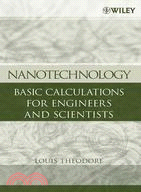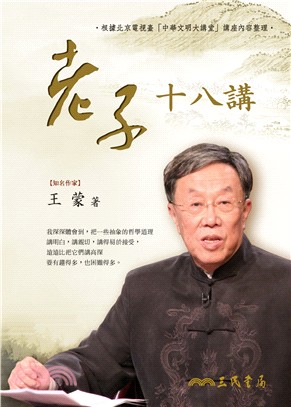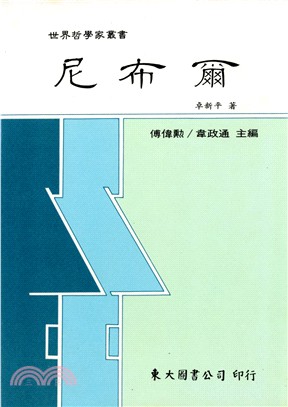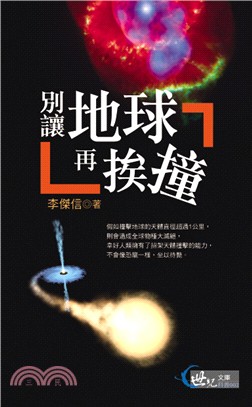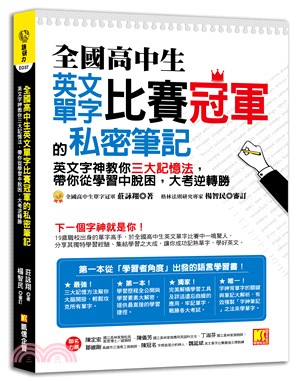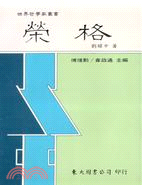Nanotechnology: Basic Calculations For Engineers And Scientists
商品資訊
商品簡介
Because nanosized particles possess unique properties, nanotechnology is rapidly becoming a major interest in engineering and science. Nanotechnology: Basic Calculations for Engineers and Scientists-a logical follow-up to the author's previous text, Nanotechnology: Environmental Implications and Solutions-presents a practical overview of nanotechnology in a unique workbook format.
The author has developed nearly 300 problems that provide a clear understanding of this growing field in four distinct areas of study:
* Chemistry fundamentals and principles
* Particle technology
* Applications
* Environmental concerns
These problems have been carefully chosen to address the most important basic concepts, issues, and applications within each area, including such topics as patent evaluation, toxicology, particle dynamics, ventilation, risk assessment, and manufacturing. An introduction to quantum mechanics is also included in the Appendix. These stand-alone problems follow an orderly and logical progression designed to develop the reader's technical understanding.
"This is certain to become the pacesetter in the field, a text to benefit both students of all technical disciplines and practicing engineers and researchers."
-Dr. Howard Beim, Professor of Chemistry, U.S. Merchant Marine Academy
"Dr. Theodore has covered most of the important nanotechnology subject matter in this ...work through simple, easy-to-follow problems."
-John McKenna, President and CEO, ETS, Inc.
作者簡介
目次
Introduction.
PART 1: CHEMISTRY FUNDAMENTALS AND PRINCIPLES.
1 Units, Conversion Constants, and Dimensional Analysis.
1.1 Background on the Metric System.
1.2 Describe the SI System of Units.
1.2.1 Seven Base Units.
1.2.2 Two Supplementary Units.
1.2.3 SI Multiples and Prefixes.
1.3 The Conversion Constant gc.
1.4 Unit Conversion Factors: General Approach.
1.5 Temperature Conversions.
1.6 Pressure Calculations.
1.7 Density and Thermal Conductivity.
1.8 Viscosity Conversions.
1.9 Air Quality Standard.
1.10 Conversion Factors for Particulate Measurements.
1.11 Significant Figures and Scientific Notation.
1.12 Uncertainty in Measurement.
2 Atoms, Elements, and the Periodic Table.
2.1 Atomic Theory.
2.2 The Avogadro Number.
2.3 Mass and Size of Atoms.
2.4 Atomic Conversions.
2.5 Atomic Number, Atomic Weight, and Mass Number.
2.6 Bismuth Application.
2.7 Elements.
2.8 Symbols for Elements.
2.9 Periodic Table Application.
2.10 Isotopes.
3 Molecular Rearrangements.
3.1 License Plate Sets.
3.2 Chemical Permutations and Combinations.
3.3 Formula Weight and Molecular Weight.
3.4 Mole/Molecule Relationship.
3.5 Pollutant Chemical Formulas.
3.6 Stoichiometry.
3.7 Limiting and Excess Reactants.
3.8 Combustion of Chlorobenzene.
3.9 Metal Alloy Calculation.
3.10 Chemical Production.
4 Concentration Terms.
4.1 Density, Specific Gravity, and Bulk Density.
4.2 Classes of Solution.
4.3 Molality versus Molarity.
4.4 Molar Relationships.
4.5 Concentration Conversion.
4.6 Chlorine Concentration.
4.7 Trace Concentration.
4.8 Ash Emission.
4.9 Dilution Factor.
4.10 Nano Exhaust to Atmosphere.
4.11 Flue Gas Analysis.
4.12 pH.
5 Particle Size, Surface Area, and Volume.
5.1 Sphere, Cube, Rectangular Parallelepiped, and Cylinder.
5.2 Parallelogram, Triangle, and Trapezoid.
5.3 Polygons.
5.4 Elipse and Ellipsoid.
5.5 Cones.
5.6 Torus.
5.7 Area to Volume Ratios.
5.8 Area to Volume Calculation.
5.9 Increase in Sphere Surface Area.
5.10 Increase in Cube Surface Area.
6 Materials Science Principles.
6.1 Metals, Polymers, and Ceramics.
6.2 Composites, Semiconductors, and Biomaterials.
6.3 Crystal Coordination Numbers.
6.4 Geometry of Metallic Unit Cells.
6.5 Geometry of Ionic Unit Cells.
6.6 Packing Factor.
6.7 Density Calculation.
6.8 Directions and Planes.
6.9 Linear Density.
6.10 Planar Density.
7 Physical and Chemical Property Estimation.
7.1 Property Differences.
7.2 Material Selection.
7.3 Vapor Pressure.
7.4 Vapor Pressure Calculation.
7.5 Heat of Vaporization From Vapor Pressure Data.
7.6 Critical and Reduced Properties.
7.7 Estimating Enthalpy of Vaporization.
7.8 Viscosity.
7.9 Thermal Conductivity.
7.10 Thermal Conductivity Application.
7.11 Nokay Equation and Lydersen’s Method.
7.12 The Rihani and Doraiswamy Procedure, and the Lee–Kesler Equation.
References: Part 1.
PART 2: PARTICLE TECHNOLOGY.
8 Nature of Particulates.
8.1 Definition of Particulates.
8.2 Dust, Smoke, and Fumes.
8.3 Mist and Drizzle.
8.4 Changing Properties.
8.5 Dust Explosions.
8.6 Adsorption and Catalytic Activity in the Atmosphere.
8.7 Particle Size.
8.8 Particle Volume and Surface Area.
8.9 Volume/Surface Area Ratios.
8.10 Particle Formation.
9 Particle Size Distribution.
9.1 Representative Sampling.
9.2 Typical Particle Size Ranges.
9.3 Particle Size Distribution and Concentration for Industrial Particulates.
9.4 Particle Size Distribution.
9.5 Median and Mean Particle Size.
9.6 Standard Deviation.
9.7 The Frequency Distribution Curve.
9.8 The Cumulative Distribution Curve.
9.9 The Normal Distribution.
9.10 The Log Normal Distribution.
9.11 Effect of Size Distribution on Cumulative Distribution Plots.
9.12 Nanoparticle Size Variation With Time.
10 Particle Sizing and Measurement Methods.
10.1 Tyler and U.S. Standard Screens.
10.2 Equivalent Diameter Terms.
10.3 Aerodynamic Diameter.
10.4 Sizing Devices.
10.4.1 Microscopy.
10.4.2 Optical Counters.
10.4.3 Electrical Aerosol Analyzer.
10.4.4 Bahco Microparticle Classifier.
10.4.5 Impactors.
10.4.6 Photon Correlation Spectroscopy (PCS).
10.5 Rectangular Conduit Sampling.
10.6 Volumetric Flow Rate Calculation.
10.7 Particle Mass Flow Rate Calculation.
10.8 Average Particle Concentration.
10.9 Equal Annular Areas for Circular Ducts.
10.10 Traverse Point Location in Circular Ducts.
10.11 Duct Flow Equation Derivation.
10.12 Source Characteristics and Variations.
11 Fluid Particle Dynamics.
11.1 The Gravitational Force.
11.2 The Buoyant Force.
11.3 The Drag Force.
11.4 The Drag Coefficient.
11.5 Equation of Particle Motion/Balance of Forces on a Particle.
11.6 Particle Settling Velocity Equations.
11.7 Determination of the Flow Regime.
11.8 Settling Velocity Application.
11.9 The Cunningham Correction Factor.
11.10 Cunningham Correction Factor Values for Air at Atmospheric Pressure.
11.11 Particle Settling Velocity – Different Regimes.
11.12 Brownian Motion/Molecular Diffusion.
12 Particle Collection Mechanisms.
12.1 Gravity.
12.2 Centrifugal Force.
12.3 Inertial Impaction and Interception.
12.4 Electrostatic Effects.
12.5 Thermophoresis and Diffusiophoresis.
12.6 Acceleration Effects.
12.7 Brownian Motion/Molecular Diffusion Effects.
12.8 Nonspherical Particles.
12.9 Wall Effects.
12.10 Multiparticle Effects.
12.11 Multidimensional Flow.
12.12 Collection Efficiency for Nanosized/Submicron Particles.
13 Particle Collection Efficiency.
13.1 Collection Efficiency: Loading Data.
13.2 Collection Efficiency: Mass Rate.
13.3 Efficiency of Multiple Collectors.
13.4 Penetration.
13.5 Collection Efficiency: Numbers Basis.
13.6 Particle Size–Collection Efficiency Relationships.
13.7 Collection Efficiency: Surface Area Basis.
13.8 Particle Size Distribution/Size–Efficiency Calculation.
13.9 Check for Emission Standards Compliance: Numbers Basis.
13.10 Anderson 2000 Sampler.
References: Part 2.
PART 3: APPLICATIONS.
14 Legal Considerations.
14.1 Intellectual Property Law.
14.2 Patents.
14.3 Contract Law.
14.4 Tort Law.
14.5 Recent Patent Activity.
14.6 Conservation Law For Mass.
14.7 Conservation Law for Energy.
14.8 The Second Law of Thermodynamics.
14.9 Allowable Patent Application Claims.
14.10 Practicing One’s Own Invention.
15 Size Reduction.
15.1 Size Reduction Objectives.
15.2 Plasma-Based and Flame-Hydrolysis Methods.
15.3 Chemical Vapor Deposition and Electrodeposition.
15.4 Sol-Gel Processing.
15.5 Mechanical Crushing.
15.6 Promising Technologies.
15.7 Energy and Power Requirements.
15.8 Potential Dust Explosions With Size Reduction.
15.9 Material Balance Size Reduction.
15.10 Size Reduction Surface Area Increase.
15.11 Fines Eductor Application.
15.12 Fines Eductor Size Reduction.
16 Prime Materials.
16.1 Metals.
16.2 Iron.
16.3 Aluminum.
16.4 Nickel.
16.5 Silver.
16.6 Gold.
16.7 Iron Oxides.
16.8 Aluminum Oxide.
16.9 Zirconium Dioxide.
16.10 Titanium Dioxide.
16.11 Zinc Oxide.
16.12 Silica Products.
17 Production Manufacturing Routes.
17.1 Carbon Nanotubes and Buckyballs.
17.2 Semiconductor Manufacturing.
17.3 Advanced Composites.
17.4 Advanced Ceramics.
17.5 Catalytic and Photocatalytic Applications.
17.6 Gas Sensors and Other Analytical Devices.
17.7 Consumer Products.
17.8 Drug Delivery Mechanisms and Medical Therapeutics.
17.9 Microelectronics Applications.
17.10 Future Activites.
18 Ventilation.
18.1 Indoor Air Quality.
18.2 Indoor Air/Ambient Air Comparison.
18.3 Sources of Contaminents in Indoor Air.
18.4 Industrial Ventilation System.
18.5 Dilution Ventilation vs. Local Exhaust Systems.
18.6 Ventilation Definitions.
18.7 Air Exchange Rate.
18.8 Accidental Emission.
18.9 Dilution Ventilation Application.
18.10 Vinyl Chloride Application.
18.11 Ventilation Models.
18.12 Minimum Ventilation Flowrate.
19 Dispersion Considerations.
19.1 Atmospheric Deposition Calculation.
19.2 Ground Deposition of Particles.
19.3 Plume Rise.
19.4 Pasquill–Gifford Model.
19.5 Ground-Level Particle Deposition.
19.6 Line and Area Sources.
19.7 Instantaneous “Puff” Model.
19.8 Instantaneous “Puff” Sources.
19.9 U.S. EPA Dispersion Models.
19.10 Dispersion in Water Systems and Soils.
19.11 Canal Concentration Profile.
19.12 Accidenctal/Emergency Discharge into a Lake/Reservoir.
20 Ethics.
20.1 Determination of Ethical Values.
20.2 Do’s and Dont's.
20.3 Codes of Ethics.
20.4 The Heavy Metal Dilemma.
Fact Pattern.
20.5 Let Them Worry About It.
Fact Pattern.
20.6 It’s In the Air.
Fact Pattern.
20.7 Cheap at What Price.
Fact Pattern.
20.8 Safety Comes First.
Fact Pattern.
20.9 Intellectual Property.
Fact Pattern.
20.10 There’s No Such Thing as a Free Seminar.
Fact Pattern.
References: Part 3.
PART 4: ENVIRONMENTAL CONCERNS.
21 Environmental Regulations.
21.1 The Regulatory System.
21.2 Air Quality Issues.
21.3 Particulate Loading.
21.4 Clean Air Act Acronyms.
21.5 Water Pollution Control.
21.5.1 Federal Water Pollution Control Act.
21.5.2 Safe Drinking Water Act.
21.5.3 Oil Pollution Control Act.
21.6 Water Quality Issues.
21.7 Clean Water Act and PWPs.
21.8 Wastewater Composition.
21.9 Solid Waste Management Issues.
21.10 Hazardous Waste Incinerator.
21.11 Nanotechnology Environmental Regulations Overview.
21.12 Nanotechnology Opponents.
22 Toxicology.
22.1 The Science of Toxicology.
22.2 Toxicology Classifications.
22.3 Routes of Exposure.
22.4 Threshold Limit Value (TLV).
22.5 Toxicology Terminology.
22.6 TLV vs. PEL.
22.7 Toxicity Factors.
22.8 OSHA and NIOSH.
22.9 Toxicology Determination.
22.10 IDLH and Lethal Level.
22.11 Chemical Exposure.
22.12 Threshold Limit Values.
23 Noncarcinogens.
23.1 Hazard Quotient.
23.2 Reference Dose.
23.3 Concept of Threshold.
23.4 Exposure Duration Classification.
23.5 Risk For Multiple Agents: Chronic Exposure.
23.6 Risk for Multiple Agents: Subchronic Exposure.
23.7 Multiple Exposure Pathways.
23.8 MCL and RfDF.
23.9 Uncertainly and Modifying Factors.
23.10 Calculating an RfD from NOAEL.
23.11 Metal Plating Facility Application.
23.12 Noncarcinogen Calculation Procedure.
24 Carcinogens.
24.1 Nonthreshold Concept.
24.1 Weight of Evidence and Slope Factor.
24.3 Carcinogenic Toxicity Values.
24.4 Benzene in Water Application.
24.5 Excess Lifetime Cancer Cases.
24.6 Action Level.
24.7 Accidental Spill.
24.8 Uncertainties and Limitations.
24.9 Multiple Chemical Agents and Exposure Pathways.
24.10 Exponential Risk Model.
24.11 Risk Algorithm.
24.12 Risk Algorithm Application for Benzene.
25 Health Risk Assessment.
25.1 Risk Definitions.
25.2 The Health Risk Evaluation Process.
25.3 Standand Values for Individuals.
25.4 Qualitative Risk Scenarios.
25.5 Example of a Health Risk Assessment.
25.6 Chemical Exposure in a Laboratory.
25.7 Laboratory Spill.
25.8 Respirators.
25.9 Performance of a Carbon Cartridge Respirator.
25.10 Sampling Program.
26 Hazard Risk Assessment.
26.1 Example of a Hazard.
26.2 Risk Evaluation Process for Accidents.
26.3 Plant and Process Safety.
26.4 Series and Parallel Systems.
26.5 Binomial Distribution.
26.6 The Poisson Distribution.
26.7 The Weibull Distribution.
26.8 The Normal Distribution.
26.9 Soil Contamination.
26.10 Event Tree Analysis.
26.11 Fault Tree Analysis.
26.12 Upper and Lower Flamability Limits.
27 Epidemiology.
27.1 Historical View.
27.2 Occupational Health.
27.3 Descriptive Studies.
27.4 Probability.
27.5 Prevalence.
27.6 Incidence Rate.
27.7 The Mean.
27.8 The Variance and the Standard Deviation.
References: Part 4.
Appendix Quantum Mechanics.
Index.
主題書展
更多書展本週66折
您曾經瀏覽過的商品
購物須知
外文書商品之書封,為出版社提供之樣本。實際出貨商品,以出版社所提供之現有版本為主。部份書籍,因出版社供應狀況特殊,匯率將依實際狀況做調整。
無庫存之商品,在您完成訂單程序之後,將以空運的方式為你下單調貨。為了縮短等待的時間,建議您將外文書與其他商品分開下單,以獲得最快的取貨速度,平均調貨時間為1~2個月。
為了保護您的權益,「三民網路書店」提供會員七日商品鑑賞期(收到商品為起始日)。
若要辦理退貨,請在商品鑑賞期內寄回,且商品必須是全新狀態與完整包裝(商品、附件、發票、隨貨贈品等)否則恕不接受退貨。



